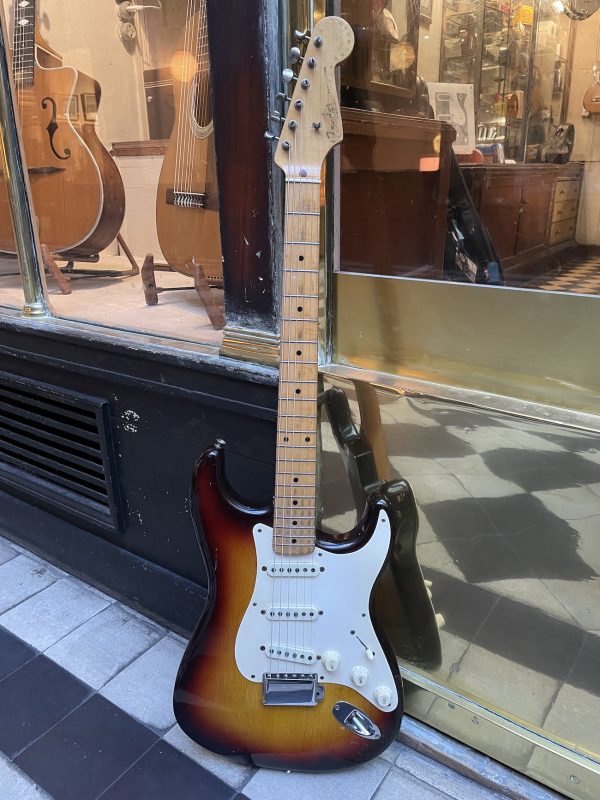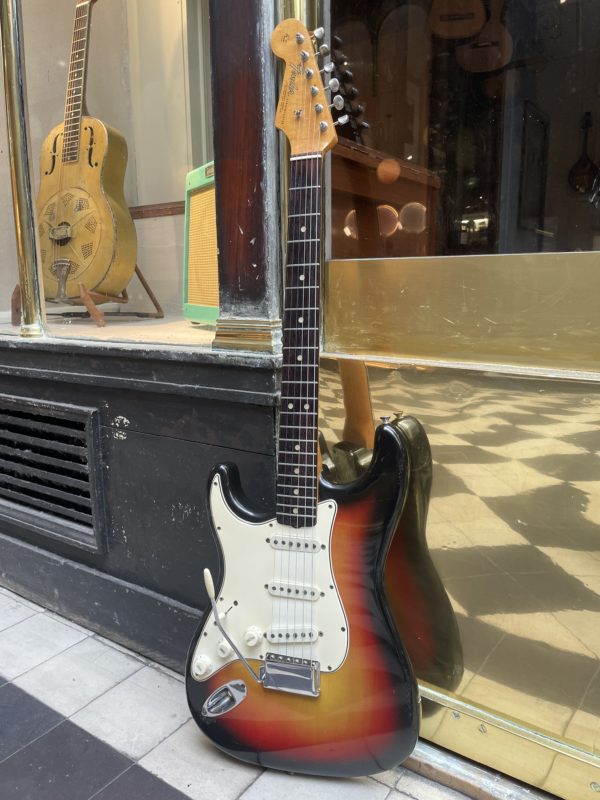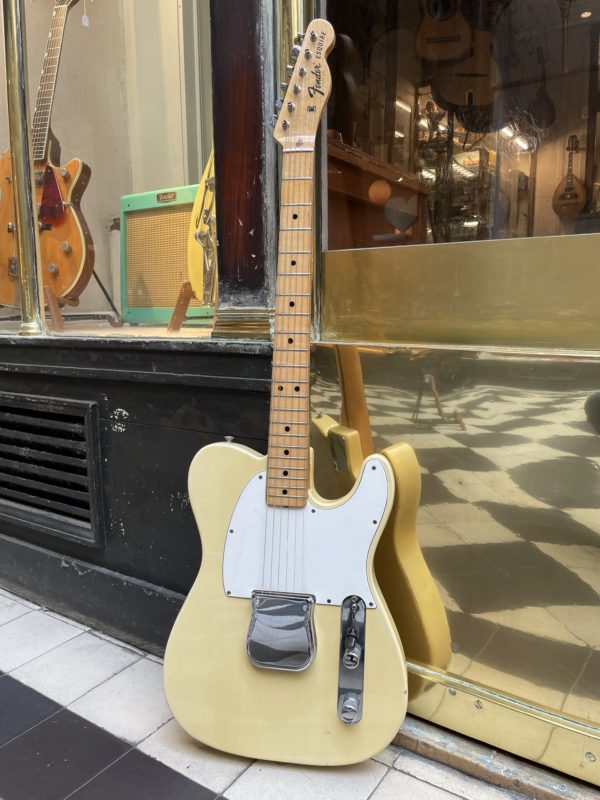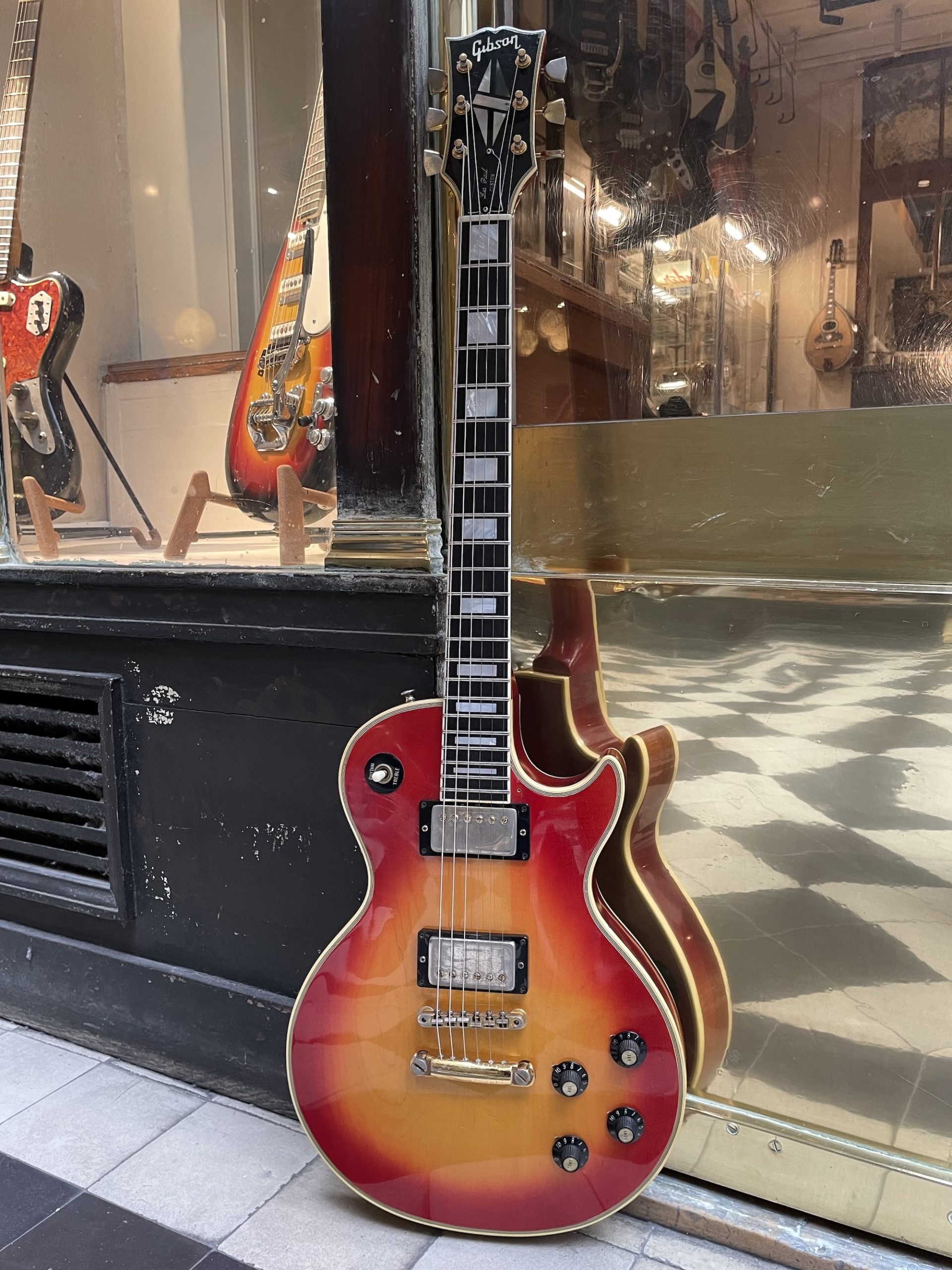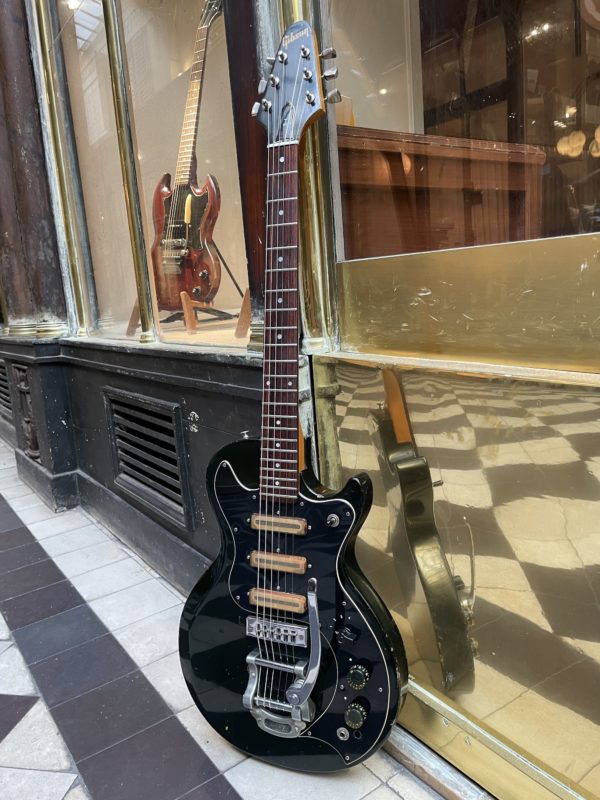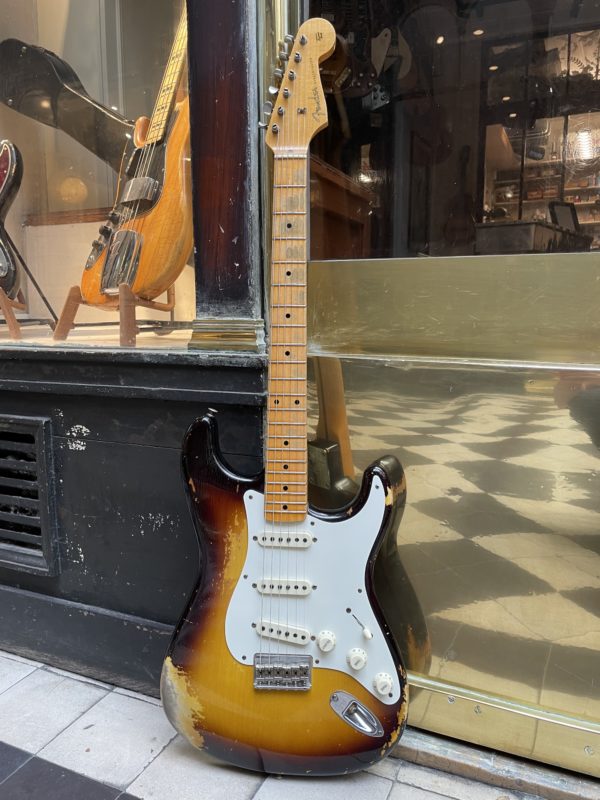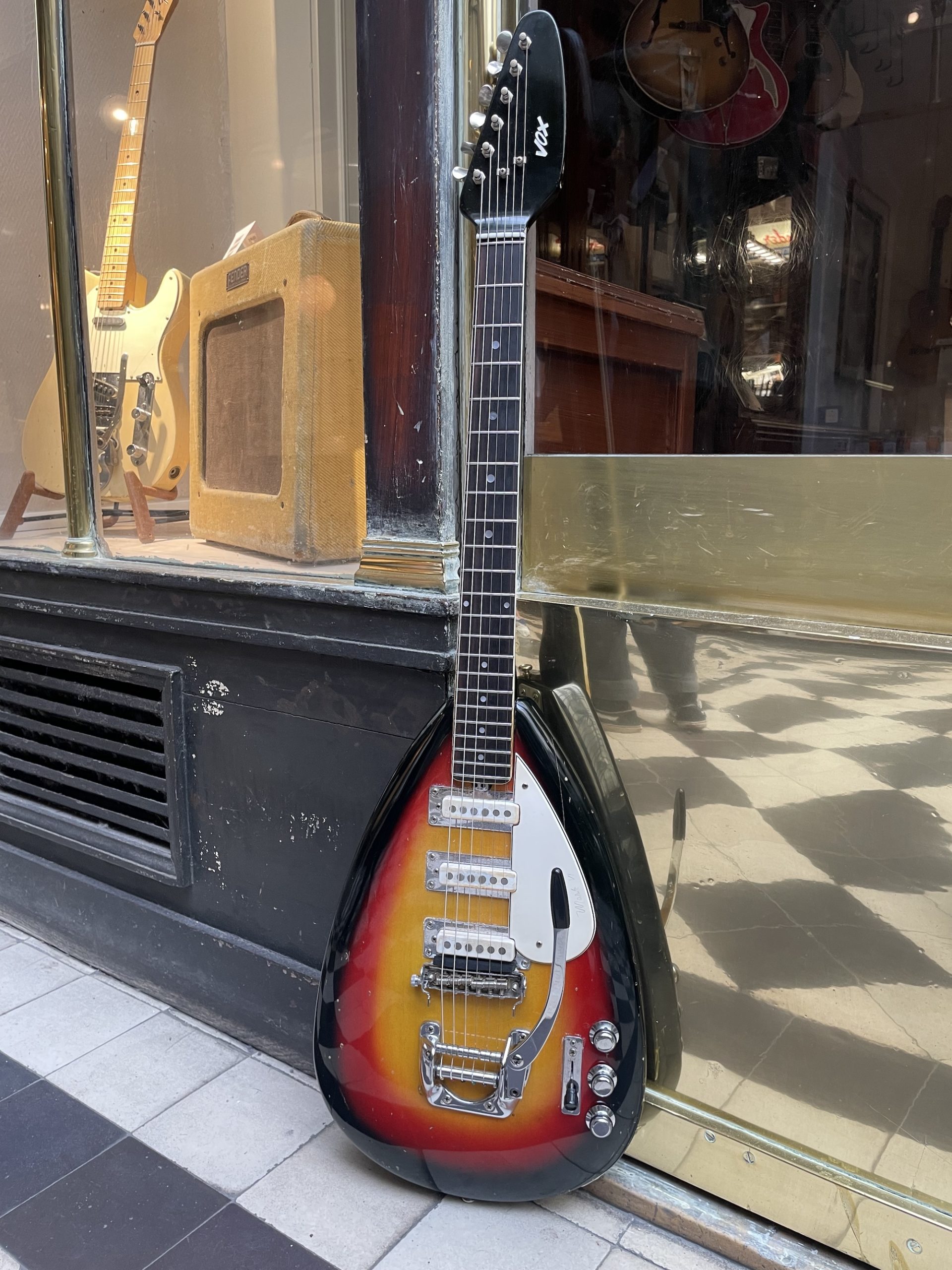Solid Body
1957 GRETSCH 6128 DUO JET
1958 FENDER STRATOCASTER
1959 GRETSCH 6130 ROUNDUP
1969 GIBSON LES PAUL CUSTOM – EX – RICHIE FAULKNER (JUDAS PRIEST)
1971 FENDER TELECASTER ROSEWOOD
2010 FENDER CS STRATOCASTER MASTERBUILT JASON SMITH
THE SOLIDBODY GUITAR
Despite appearances and urban legends, electric guitars made from a solid piece of wood, know as solidbody guitars, have real acoustic qualities. These are reduced and discreet when played without amplification, but which is indeed part of the timbre of the instrument. Of course the pickups of the guitar as well as all the “filters” made up of potentiometers and capacitors are important in the sound of a purely electric guitar, but never more than 55%. This means that 45% of the sound amplified by electronics is that of the woodwork: the types of wood used and the worker’s labor. Moreover, with equivalent electronics on a standard Gibson wiring with two humbuckers or P-90 pickups, the nature of the timbre, the dynamics, the density of the registers, and the natural compression of the sound differ greatly between a Gibson ES-175, which despite its hollow body can only really be heard when connected to an amplifier, and a Gibson ES-335, a Gibson Les Paul Standard model (maple body on mahogany, rosewood fingerboard) or Custom (all mahogany body, ebony fingerboard), or a guitar with a totally different style of construction such as the Gibson SG. The same applies to all builders and, with equal electronics, the Fender Telecaster or Fender Stratocaster with a maple neck or a rosewood fingerboard do not put out the same tone. The same goes for a pine body which sounds different from an alder or ash body.
During the 1950s and into the mid-1960s, Gibson and Fender, the two biggest brands of electric instruments clashed: first geographically, the culture of the West Coast versus that of the East Coast, when the sophistication of city dwellers’ jazz competes with the drawl of a countryside western-swing; then, conceptually, when the sun of classical guitar making fades away in front of the modernity of a carpentry kit – which is what Fender’s fabulously simple concept can be summed up to – ; finally, humanly, when for 15 years, as if they were competing in the Boat Races of the Oxford and Cambridge colleges, two men, Leo Fender and Theodore McCarthy (1909-2001) for Gibson, rivaled in effort and talent to push their company to the top of the guitar world: Fender Telecaster, Fender Stratocaster, Fender Jazzmaster, Fender Jaguar, Fender Mustang, Fender Precision Bass, Fender Jazz Bass, Fender Electric XII, Fender Bass VI, versus Gibson Les Paul Gold Top with P-90 pickups then Gibson Les Paul Sunburst with humbuckers pickups, Gibson Flying V, Gibson Explorer, Gibson Les Paul Junior, Gibson Les Paul TV, Gibson SG, Gibson Firebird, or in order of appearance Gibson ES-335, Gibson ES-345, Gibson ES-355, Gibson ES-330, Gibson EB-0, Gibson EB-2D, Gibson Thunderbird basses. Don’t throw away any more, all the great classics around which the contemporary electric guitar industry still revolves and still today are gathered here. If we add a few epigonal models from the valiant outsiders Gretsch, Rickenbacker, Guild, Mosrite, Danelectro, even Vox or Höfner in Europe, all these creations have become true archetypes of the solidbody and semi-hollowbody electric guitar. As for violin making modeled on the model of a Stradivarius, an Amati, a Garneri, if you add or remove something from them, the magic breaks.
To draw up an exhaustive list of those who have taken the solidbody electric guitar to the pinnacle is a challenge, let us only retain a few names of guitar heroes in the exclusive domain of rocj and who have definitely changed the face of the guitar world: Cliff Galupp ( 1930-1988), Hank Marvin (1941), James Burton (1939), Jimi Hendrix (1942-1970), Mike Bloomfield (1943-1981), Peter Green (1946-2020), Keith Richards (1943), Jimmy Page (1944), Jeff Beck (1944), Alvin Lee (1944-2013), Albert Lee (1943), Eric Clapton (1945), Rory Gallagher (1948-1995), Frank Zappa (1940-1993), Rober Fripp (1946), Danny Gatton (1945-1994), Tony Iommi (1948), Johnny Winter (1944-201’), Ritchie Blackmore (1945), David Gilmour (1946), Carlos Santana (1947), Harvey Mandell (1945), Chris Speeding (1944), Mark Knopfler (1949), Angus Young (1955), George Harrison (1943-2001), Pete Townshend (1945), Brian May (1947), Paul Kossoff (1950-1976), Gary Moore (1952-2011), Stevie Ray Vaughan (1954-1990), Randy Roads (1956-1982), Eddie Van Halen (1955-2020), James Jamerson (1936-1983), Jaco Pastorius (1951-1987), etc. This is enough to spend a few good hours of electric guitars in the company of this pantheon.




